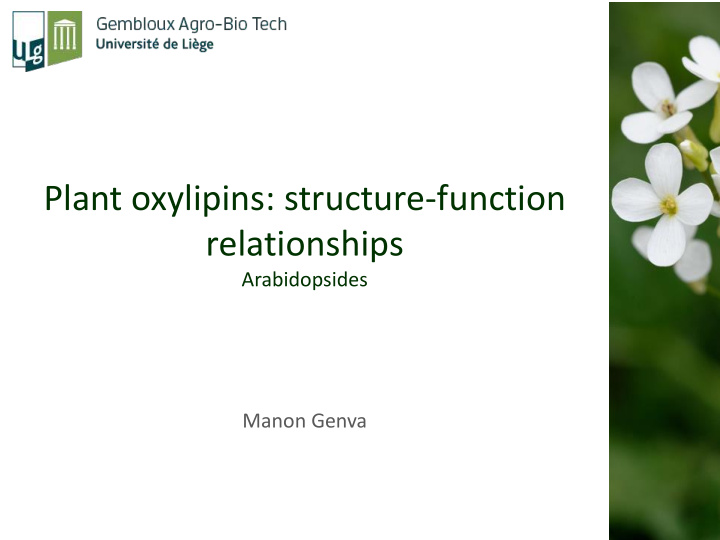



Plant oxylipins: structure-function relationships Arabidopsides Manon Genva
Context Project Results Conclusion 1. Context • Plant oxylipins – Unsaturated fatty acids oxidation Jasmonic acid – Important roles • Biotic/abiotic stresses – Forms in plants • Free • Esterified Arabidopside B – High diversity: galactolipids , phospholipids, … 2
Context Project Results Conclusion • Arabidopsides • Same structure • Found in few vegetal species Stress Wounding, cold, photoperiod, Bacteria pathogen OPDA Arabidopsides production Arabidopsis thaliana L. dn-OPDA 3
Context Project Results Conclusion • Arabidopsides functions – Production following stress plant defense mechanisms Hypotheses OPDA/ dn-OPDA supply • Signaling pathway modulation • For jasmonic acid production Direct action on pathogens • ↓ growth of pseudomonas syringae (in-vitro) 4
Context Project Results Conclusion 2. Project • Goal: determination of arabidopsides involvement in plant defense mechanisms – Lipid molecules • Interact/found in plant membranes – Project • Purification of pure molecules • Study of molecules/membranes interaction in-vitro & in-silico 5
Context Project Results Conclusion 3. Results 1. Extraction of pure arabidopsides Preparative HPLC CHCl 3 :aceton (9:1) Stress Purification Aceton:methanol • C18 column (9:1) • Acetonitril:water gradient • UV detection 1. Apolar lipids 2. Glycolipids 6
Context Project Results Conclusion 1. Extraction of pure arabidopsides 7
Context Project Results Conclusion 1. Extraction of pure arabidopsides Arabidopside A 8
Context Project Results Conclusion 1. Extraction of pure arabidopsides 9
Context Project Results Conclusion 2. Arabidopsides in-silic o modelling • Generation of arabidopside A 3D structures – 2 stereoisomers (R & S) • l 10
Context Project Results Conclusion 2. Arabidopsides in-silic o modelling • Generation of arabidopside A 3D structures • Structure Tree – Informatic tool • Structure optimization in force field – Generation of thousand structures based on molecules torsion axis • Lowest energy structure is selected for each stereoisomer 11
Context Project Results Conclusion 2. Arabidopsides in-silic o modelling R stereoisomer OPDA Dn-OPDA Sugar 12
Context Project Results Conclusion 2. Arabidopsides in-silic o modelling S stereoisomer OPDA & dn-OPDA close Dn-OPDA OPDA Sugar 13
Context Project Results Conclusion 2. Arabidopsides in-silic o modelling • Generation of arabidopside A 3D structures • Structure Tree • Hypermatrix – Study interactions between • Interest molecules (structures generated before) • Plant membrane lipids (monolayer) 14
Context Project Results Conclusion 2. Arabidopsides in-silic o modelling • Hypermatrix Fixed molecule Lipids • Rotation • Favorable energy Fixed molecule surrounded by lipids Interaction energies calculated • Lipids /molecule/ lipids Arabidopside A (R) GIPC 15
Context Project Results Conclusion 2. Arabidopsides in-silic o modelling • Hypermatrix: interaction energies – Surrounding arabidopsides lipids energies compared to monomolecular lipids energies 160 Favorable interaction percentage GCer and PLPC: Favorable 140 120 Sito and GIPC: No favorable 100 80 (%) 60 PLPC: (R) more favorable than (S) 40 20 0 GCer PLPC sito GIPC GCer PLPC sito GIPC (R) (S) Arabidopside A 16
Context Project Results Conclusion 4. Conclusion • Arabidopsides can be extracted and purified from stressed plants • In-silico simulations – Arabidopsides can positively interact with plant plasma membrane lipids • Perspectives – In-vitro analysis • E.g: are arabidopsides able to permeabilize plant membranes? 17
Thank you for your attention
Recommend
More recommend